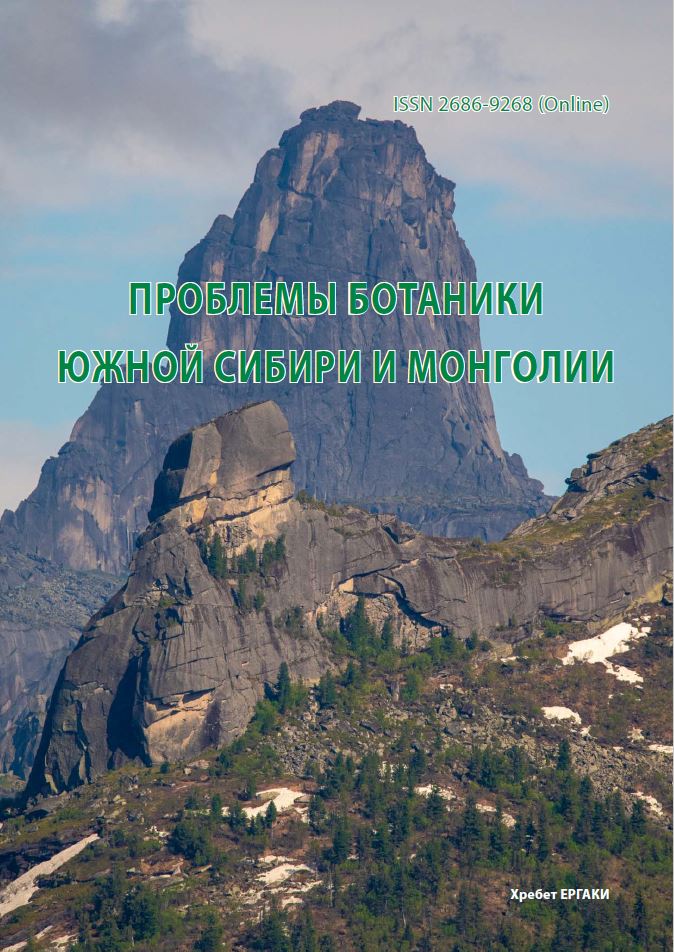Lichens of carbonate substrates of the Patom Highlands (Eastern Siberia)
УДК 582.29:581.93(571.53)
Abstract
The study of lichens of carbonate substrates of the Patom Highlands was carried out. 177 samples were collected and 28 species of lichens were identified. Among the discovered species there are representatives of both strictly calciphilous flora and lichens of the eurysubstrate group. Calciphilic species constitute a special group of lichens, usually xerophytic or even ultraxerophytic, and have a complex of adaptations to life on carbonate substrates, and adaptation strategies affect not only the fungal component, but also the photobiont. As adaptations to xerothermic habitat conditions, lichens are considered to have a squamous thallus, the presence of pruritus, an epinecral corteх of the thallus, as well as cyanoprokaryotes as a photobiont. Some of the discovered species of cyanobiotic lichens are rare in Russia, among such species are Synalissa symphorea (Weber) Poelt and Racodium rupestre Pers. Increased resistance to adverse climatic conditions is provided to them by blue-green algae as a photobiont, or rather, their mucous membranes surrounding cells and leveling the effects of high humidity - dryness, as well as temperature fluctuations. The carbonate substrates of the Patom Highlands are inhabited by a peculiar complex of lichens, among which there are both ecologically plastic, occurring quite often and under various conditions, and specific species with a narrow ecological amplitude. It is carbonates that are «guides» to the northern latitudes of heat-loving species that have a number of specific adaptations.
Downloads
Metrics
References
Воскресенский С. С. Геоморфология Сибири. - М.: Изд-во МГУ, 1962. - 352 с.
Голубкова Н. С. Конспект флоры лишайников Монгольской Народной Республики. - Л.: Изд-во «Наука», 1981. - 200 с.
Золотарев А. Г. Рельеф и новейшая структура Байкало-Патомского нагорья. - Новосибирск: Изд-во «Наука», 1974. - 120 с.
Кропоткин П. А. Отчет об Олекминско-Витимской экспедиции для отыскания скотопрогонного пути из Нер-чинского округа в Олекминский, снаряженной в 1866 году олекминскими золотопромышленниками // Записки Императорского Русского географического общества. - Т. 3. - СПб.: Типография Безобразова и Комп., 1873. -934 с.
Макрый Т. В. Слизистые цианобионтные лишайники Оренбургского заповедника (Южный Урал, Россия) // Известия Иркутского государственного университета. Серия Биология. Экология, 2022. - Т. 41. - С. 35-44. DOI: 10.26516/2073-3372.2022.41.35
Список лихенофлоры России. - СПб.: Наука, 2010. - 194 с.
Урбанавичюс Г. П. Род Scytinium (Ach.) Gray (Collemataceae, Lichenized Ascomycota) в лихенофлоре Кавказа // Ботанический вестник Северного Кавказа, 2016. - № 1. - С. 56-71.
Флора лишайников России: Биология, экология, разнообразие, распространение и методы изучения лишайников. - М.-СПб., 2014. - 392 с.
Ходосовцев А. Е., Надеина О. В., Ходосовцева Ю. А. Эпигейные ассоциации лишайников Равнинного Крыма (Украина) // Черноморск. бот. журн., 2014. - Т. 10 (2). - С. 202-223. DOI: 10.14255/2308-9628/14.102/5.
Hamlett C. A. E., Shirtcliffe N. J., Pyatt F. B., Newton M. I., McHale G., Koch K. Passive water control at the surface of a superhydrophobic lichen // Planta, 2011. - Vol. 234 (6). - P. 1267-1274. DOI: 10.1007/s00425-011-1475-z.
Jorge-Villar S. E., Miralles I., Capel Ferronc C., Hernandez Raman V. Spectroscopy study of lichens using three spectrometers under different experimental conditions: analyses of the results with relevance for extraplanetary exploration // Analytical Methods, 2011. - Vol. 3. - P. 2783-2791. DOI: 10.1039/c1ay05268c
Muggia L., Hafellner J., Wirtz N., Hawksworth D. L., Grube M. The sterile microfilamentous lichenized fungi Cystocoleus ebeneus and Racodium rupestre are relatives of plant pathogens and clinically important dothidealean fungi // Mycological research, 2008. - Vol. 112. - P 50-56. DOI: 10.1016/j.mycres.2007.08.025
Otalora M. A. G., Jorgensen P. M., Wedin M. A revised generic classification of the jelly lichens, Collemataceae // Fungal Diversity, 2014. - Vol. 64 (1). - P. 275-293. DOI: 10.1007/s13225-013-0266-1
Prieto M., Martinez I., Aragon G., Gueidan C., Lutzoni F. Molecular phylogeny of Hereroplacidium, Placidim and related catapyrenioid genera (Verrucariaceae, lichen-forming Ascomycota) // American Journal of Botany, 2012. -Vol. 99 (1). - P. 23-35. DOI: 10.3732/ajb.1100239
Sanders W. B., Masumoto H. Lichen algae: the photosynthetic partners in lichen symbioses // The Lichenologist, 2021. - Vol. 53. - P. 347-393. DOI: 10.1017/S0024282921000335
Schaper T., Ott S. Photobiont Selectivity and Interspecific Interactions in Lichen Communities. I. Culture Experiments with the Mycobiont Fulgensia bracteata // Plant. Biol., 2003. - Vol. 5. - P. 441-450. DOI: 10.1055/s-2003-42711
Shi H., WangX., Zhou Y., Liu D., Zhang Y., YangM., Timdal E., WangL. Three new species and one new combination of Gypsoplaca (lichenized Ascomycota) from the Hengduan Mountains in China // Mycological Progress, 2018. - Vol. 17. -P. 781-790. DOI: 10.1007/s11557-018-1396-3



